| Return home | 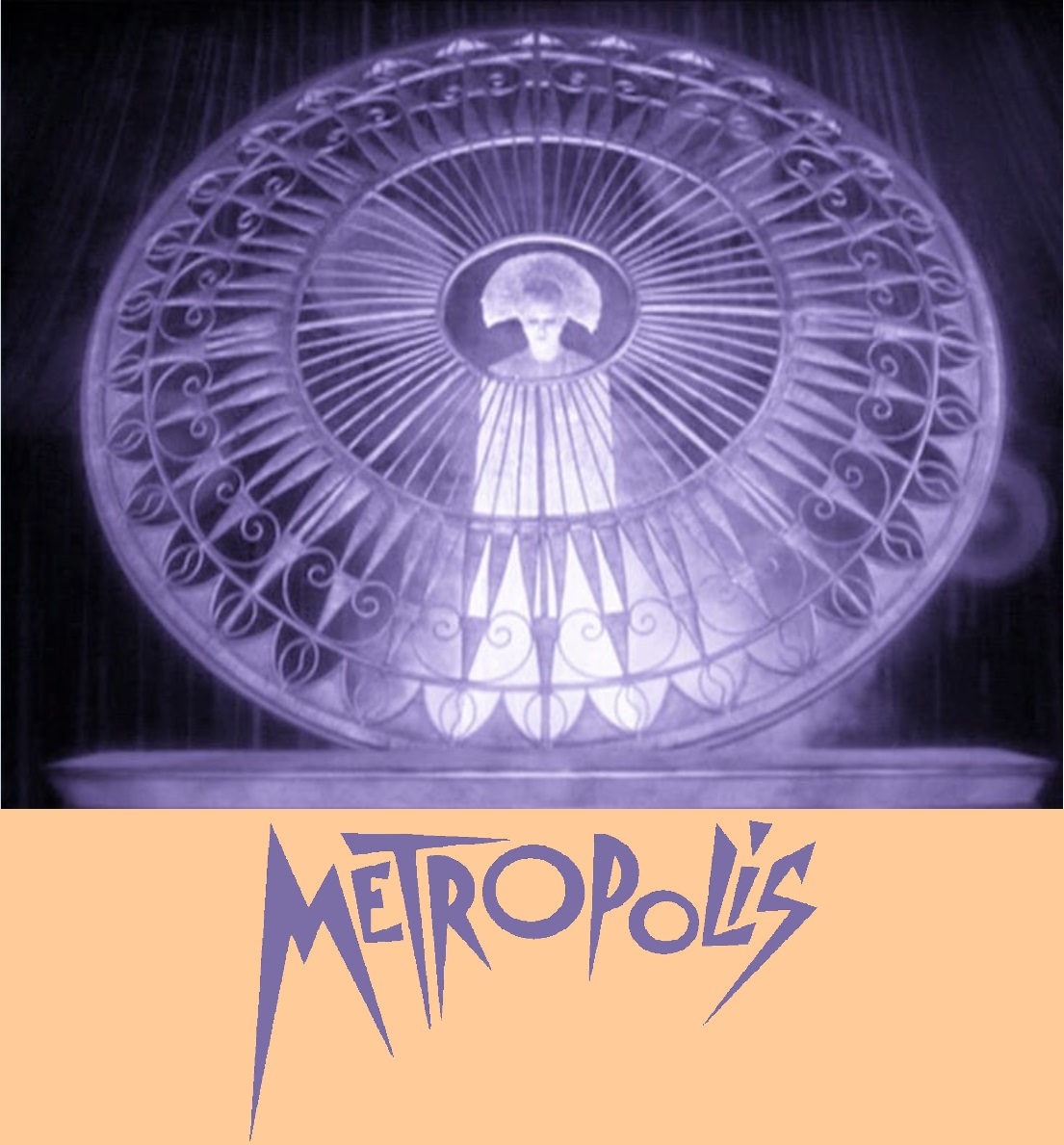 |
Return to previous page |
18 March 1963: The 1st Nordwestdeutscher Filmverleih
(NWDF) Edition
(NWDF) Edition

The Nordwestdeutscher Filmverleih (NWDF) poster of March 1963, 59.4cm × 42cm (23½" × 16½").
Under the authority of Erich Johann Anton Pietrek, active 1930–1968, died 1989.
Why does this poster emphasize Heinrich George at the expense of everybody else?
This is why:
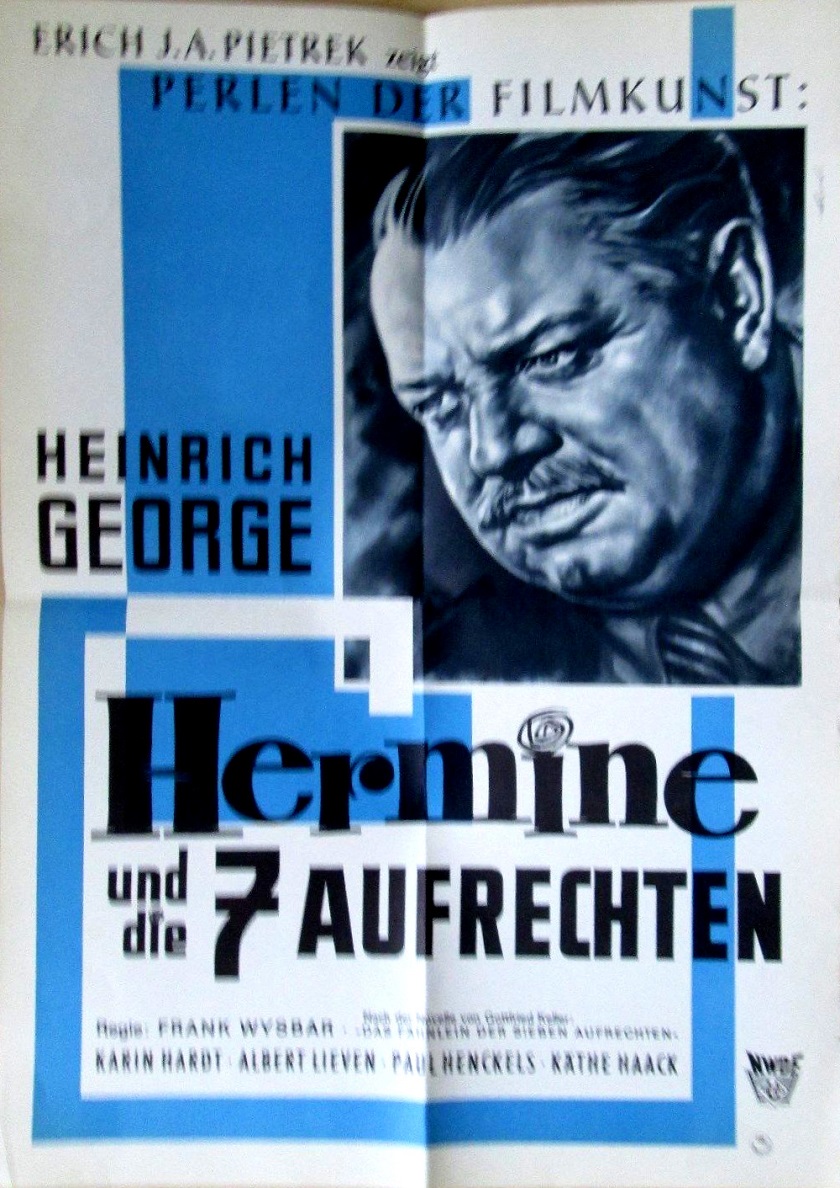
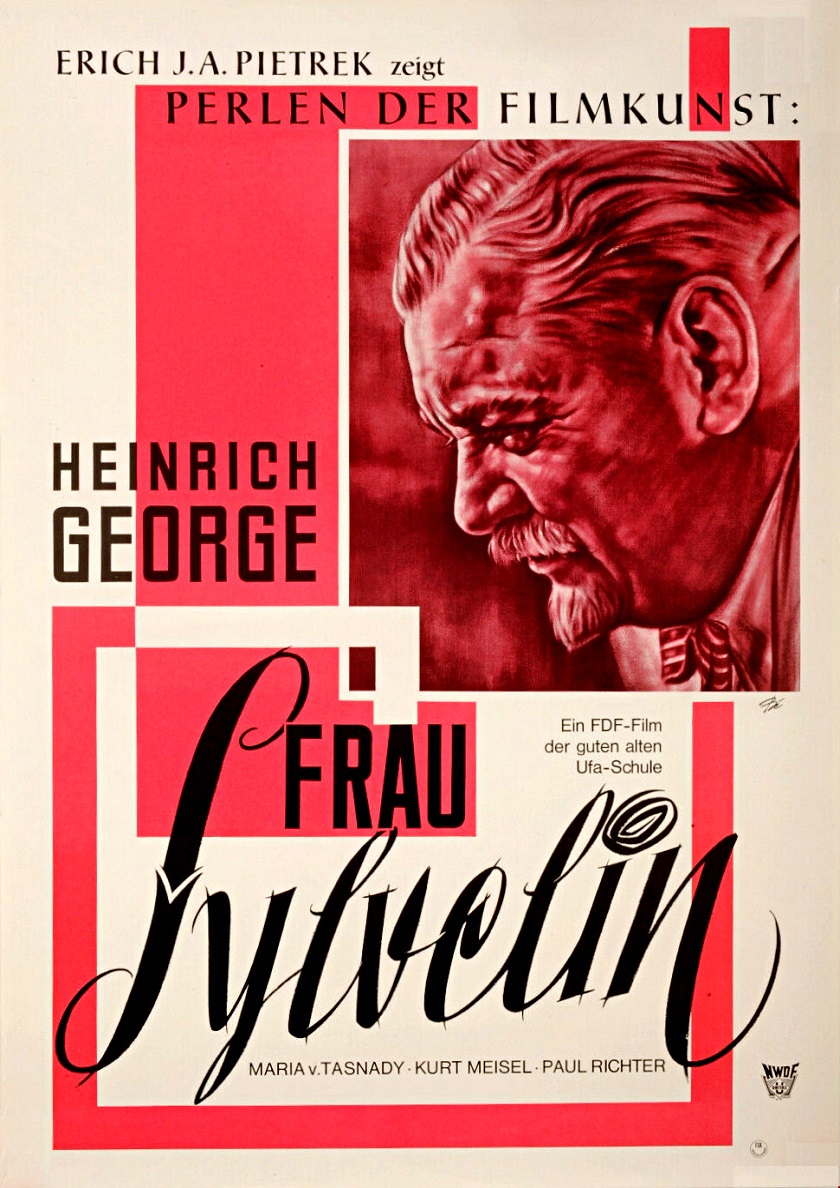


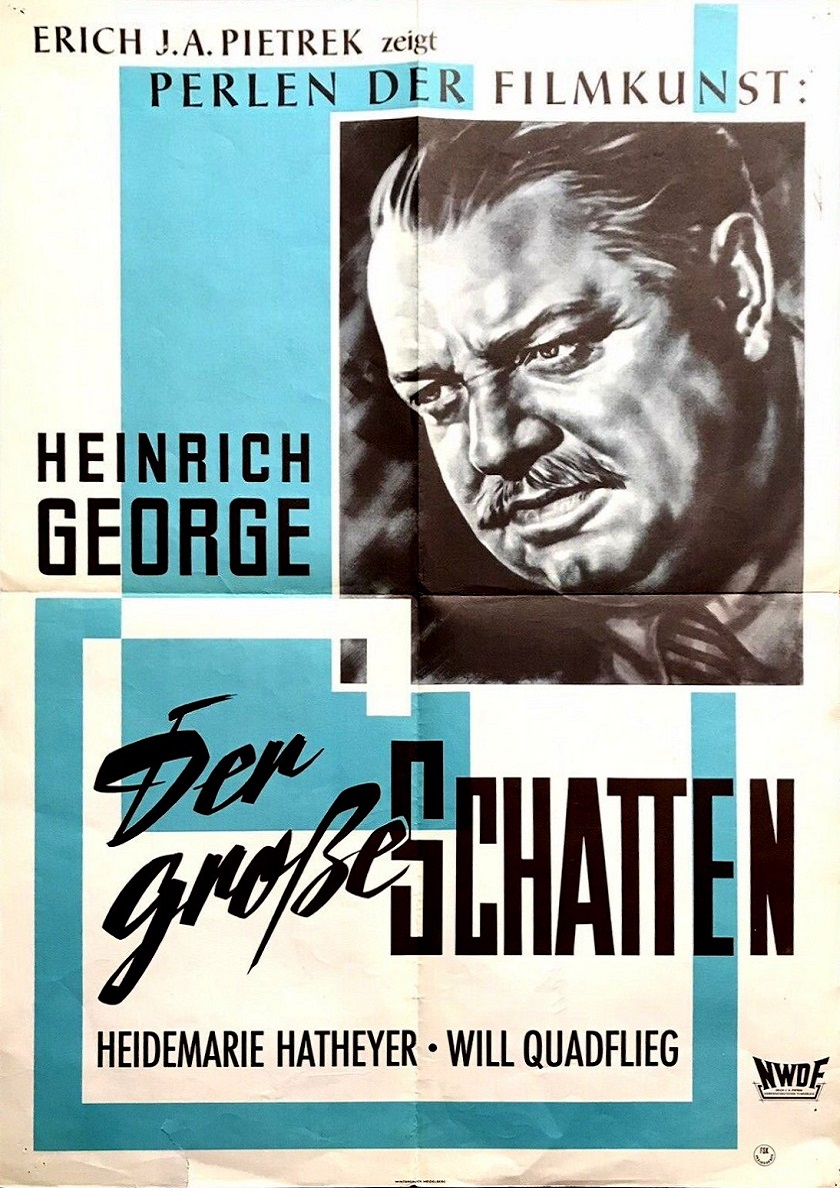
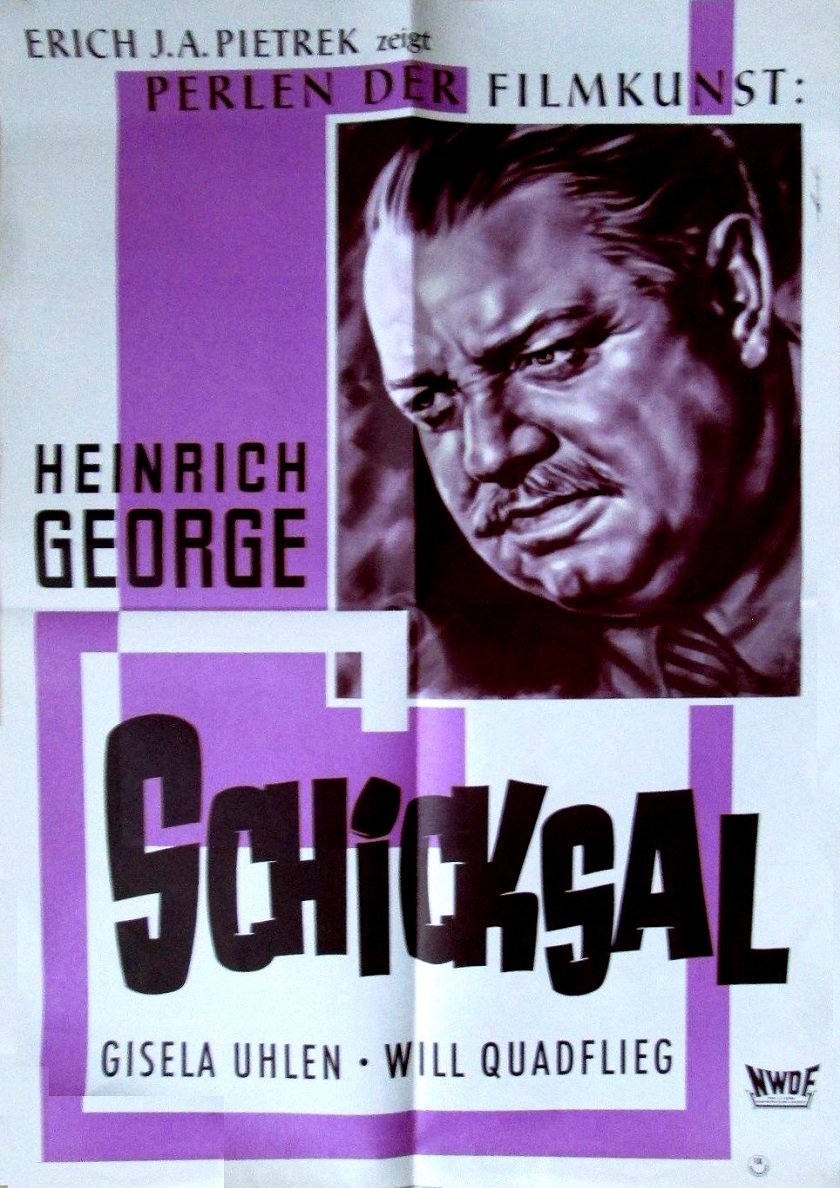

If we are to judge from the posters above,
we can conclude that some person or persons unknown wished to sponsor a reissue of a series of movies
in which Heinrich George appeared, and sought out a distributor,
which was found in a brand-new firm called Nordwestdeutscher.
The Heinrich George story, by the way, makes me sad.
He was a Commie who, in order to keep food on his table,
compromised and agreed to make films under the thumb of the Nazis.
At war’s end, the Soviets imprisoned him and starved him to death.
Can’t win for losin’.
Apart from Metropolis, all the posters above are for Nazi productions.
Nordwestdeutscher has come up rather frequently above.
Now it’s time to examine it.
In early 1963,
Nordwestdeutscher Filmverleih- und Vertrieb e. K. (eingetragener Kaufmann = registered sole trader) of
Düsseldorf licensed the rights to Metropolis
and thus was able to use as its source the material held by the British Film Institute,
and I had this all wrong, all wrong, all wrong.
In the BFI’s possession was a copy negative, certainly derived from the very same lavender that Ufa had sold to MoMA in 1936.
Do you remember above, in the section on Iris Barry, in which I brought to your attention
the recent discovery that the Ufa camera negative, as it stood in 1936, was not the original?
Some of the missing sequences had been filled in with duplicates,
and it seemed that spares replaced other missing sequences.
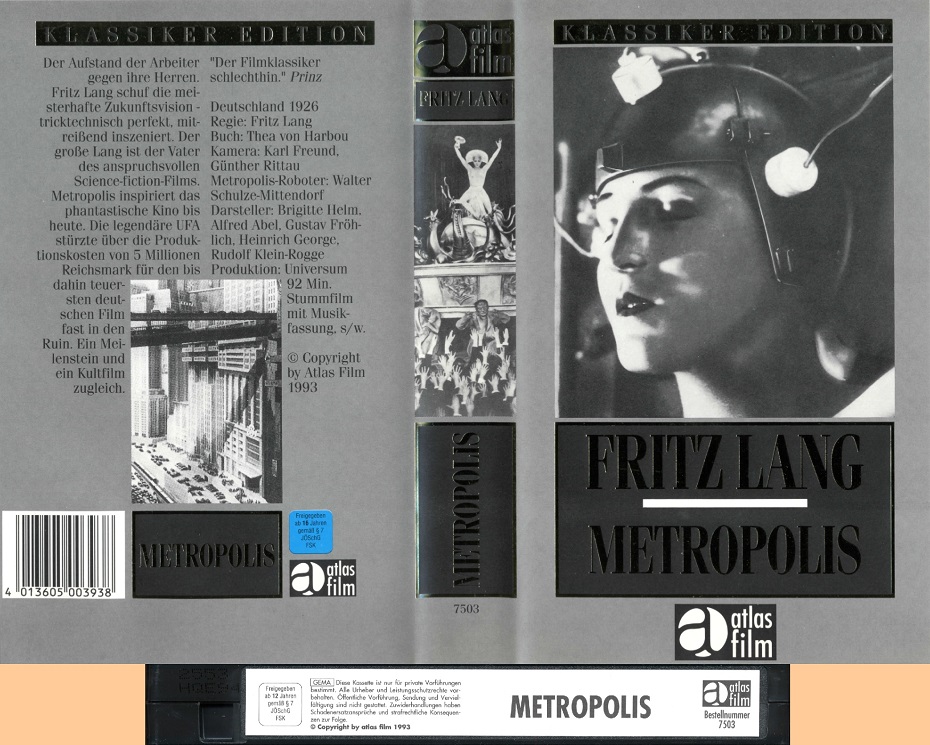
The Official VHS Release of the 1963 Nordwestdeutscher Filmverleih Edition
Well, now that I have finally seen the official Atlas Film VHS release of the Nordwestdeutscher edition, oh yeah!
Oooooooooooooog.
The evidence is all over the place.
The Ufa camera negative, as it stood in 1936, was a Frankenstein’s monster of patchwork upon patchwork.
My best guess is that Nordwestdeutscher ran off a dupe negative.
So there would have been a generational loss,
and there were anomalies, too, some of which I do not understand at all.
As usual, the Nordwestdeutscher edition was missing the left side of the image to make way for the music track.
That, of course, was because Ufa had cropped off the left side when it made the lavender for MoMA.
Now, the music track is really interesting.
Much of it was based on Huppertz’s original score,
but rearranged for piano, with occasional interludes from an organ and a few other interludes from drums.
Who did the arrangement? Who were the musicians?
There is no credit.
Was this essentially the score that was shipped out to the German nabes in August 1927 and for later releases into the 1930’s?
I don’t know. Maybe?
Not only is there no music credit, there are no credits at all!
 The only opening credit |
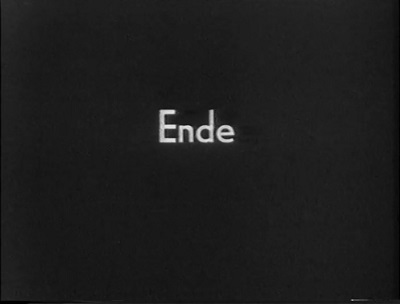 The only closing credit |
Because the titles were translated from MoMA’s English back into German,
Joh becomes John and Josaphat becomes Joseph.
The quality of the image is surprisingly good,
despite being one generation further removed from the BFI copy negative.
The flicker is minimal, the images are sharp, the contrast is good.
I was surprised, though, to see two sequences with a duplicated frame line.
That was the result of footage being misframed in a printer.
How did that get in there? I was totally confused.
Then there were a few shots that had printed-in framing problems, and so the black frameline appeared at the top of the image.
That puzzled me for a good 30 minutes or so —
until I remembered that Martin Koerber had written that there was indeed dupe replacement footage in the 1936 neg.
A ha!!!!!
I didn’t know it would be that obvious, but, yes, it was that obvious.
Now I would like to know precisely which shots were pulled from the cans of “spares.”
What I just wrote above is pretty darned abstract, huh?
You don’t have the foggiest notion what I’m blathering on about, do you?
Let me show you.
|
Above is an example of something, but I don’t know what.
I do not understand this. At all. I do not. I do not. I do not.
The telecine operator misframed and is showing all of the top of the image, a bit too much of it actually,
and is lopping off the bottom of the image.
At the top, you can see a whisp of a frameline.
As the shot goes on, something slips in the printer.
The image stays steady, but the newly created Academy frameline creeps downwards.
That occurs right at the end of Reel 3.
Everything is back to normal with the beginning of Reel 4.
I cannot explain that to save my life.
|
|
The negative of this brief sequence was damaged beyond repair,
and so a release print was duplicated to make a new negative, but it was misprinted, out of frame,
resulting in a second frameline across the top of the image.
Again, I have never operated a
printer,
nor have I ever even met one in person,
and so I am clueless how this could happen, but it happens, a lot.
The misframe during the copying also resulted in the image being above the centerline.
Since the height was cropped for this video transfer, the top of the legend was missing.
The telecine operator turned the framing knob to lower the image,
but the next shot, presumably from the camera negative, was framed correctly, resulting in a black frameline at the top.
The telecine operator then turned the knob back up, not enough to center the image,
but only enough to eliminate the frameline.
|
|
The negative for this moment was damaged beyond repair,
and so a release print was duplicated and a copy negative made from it.
This was run through a printer misframed, again resulting in a second frame line, lighter than the rest of the image, near the top.
|
Those are not the only three anomalies that puzzle me.
There are others, too, but they are not quite so blatant.
I definitely detected some grainy sections, definitely copies derived from release prints.
Nordwestdeutscher licensed the rights at the beginning of 1963,
and we learn from
Schnittberichte that
“On the occasion of the 50th anniversary of the Berlin ‘Marmorhaus’ in March 1962,
‘Metropolis’ was performed again in Germany for the first time.”
The 50th anniversary of the Berlin Marmorhaus was on
18 March 1963, not 1962,
and Nordwestdeutscher
did not yet exist in 1962.
Some sources say that the movie did not then go into general release until 1964.
Is that true?
I don’t know. Clueless.
 I’ve been doing an inordinate amount of eBaying,
and so I just received an Italian VHS published by Broadcast Milano,
part of its series of “100 Film per 100 Anni di Cinema.”
It is from a very poorly made 35mm dupe, a miserable-looking thing, and quite battered, too.
It in turn derives from a deplorably bad dupe of the Nordwestdeutscher Filmverleih German edition of 1963,
with the Nordwestdeutscher’s piano-organ-drum music track.
As with the Atlas German VHS release, there is no music credit.
At the end is a new Chiron credit, Gruppo Logica 2000, with a 1990 date.
The tape runs only about 86 minutes at 25fps, which is about 89½ minutes at 24fps.
That’s three minutes shy of the official VHS released by Atlas in Germany in 1993.
Which three minutes are missing?
Heck if I know.
I am not in the mood to run the two side by side to see where they go out of sync.
The opening titles are Italian, without any sound.
We’ll identify that snippet shortly.
The music fades in with the animated METROPOLIS credit,
and from thereon out, the German titles are removed and replaced with Chiron titles in Italian.
I’ve been doing an inordinate amount of eBaying,
and so I just received an Italian VHS published by Broadcast Milano,
part of its series of “100 Film per 100 Anni di Cinema.”
It is from a very poorly made 35mm dupe, a miserable-looking thing, and quite battered, too.
It in turn derives from a deplorably bad dupe of the Nordwestdeutscher Filmverleih German edition of 1963,
with the Nordwestdeutscher’s piano-organ-drum music track.
As with the Atlas German VHS release, there is no music credit.
At the end is a new Chiron credit, Gruppo Logica 2000, with a 1990 date.
The tape runs only about 86 minutes at 25fps, which is about 89½ minutes at 24fps.
That’s three minutes shy of the official VHS released by Atlas in Germany in 1993.
Which three minutes are missing?
Heck if I know.
I am not in the mood to run the two side by side to see where they go out of sync.
The opening titles are Italian, without any sound.
We’ll identify that snippet shortly.
The music fades in with the animated METROPOLIS credit,
and from thereon out, the German titles are removed and replaced with Chiron titles in Italian.
I hope the above stays in sync when you play it.
It usually stays in sync for me, but not always.
The (pathetically stupid) disclaimer was created on a Chiron.
The main title, director title, and studio title have no sound and were pulled from a bad dupe of an old Italian print.
The music begins when a bad dupe of the Nordwestdeutscher Filmverleih film finally kicks in.
The first title, “Un giorno di lavoro,” was created on a Chiron to replace the original Nordwestdeutscher German title.
Did you notice something strange about the original Italian main title?
“DRAMMA IN 5 PARTI.”
Drama in 5 parts.
In silent films, “parts” were reels.
Is this saying that the Italian edition was a mere five reels?
Yes!
Those opening titles were copied from the Pathéscope 9.5mm edition of December 1931.
Pathéscope sold Metropolis in several different languages; namely, German, Italian, French, Spanish, and English.